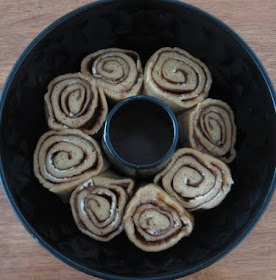
I'm definitely sure you guys want to see these now, on January 5th, during the "I never want to see another sugar-oriented food ever again" phase, right? Of course, we seem to have surpassed that phase and gone straight for more cookies, so let's just run with it.
We produced a pretty substantial amount of baked business, considering there were only two of us to feed. This also meant a "substantial amount" could consist of one batch of cookies and one cake. Both came from
The Great Scandinavian Baking Book, which I highly recommend.
First I busted out the flour and made these refrigerator cookies.
Swedish farmer cookies2 cups flour
1 1/2 tsp baking powder
1/4 cup sugar
1 cup slivered almonds
1 tbsp molasses
2/3 cup softened butter
1 egg
2 tbsp water
These are super, super easy. Just throw all the ingredients in a mixing bowl and mix them well. If you discover that you have forgotten to buy pre-slivered almonds at the Persian market, you can sliver whole almonds by hand. It's ok! It doesn't take that long, and you get nice pieces of contrast skin as well. Just try for the thinnest pieces possible, since they'lll make for a nicer texture later.

You will note that the dough is pretty crumbly. This is ok, though; it isn't actually dry, and holds together well.
Form your dough into three long cylinders about an inch and a half in diameter. I mostly just used my hands instead of trying to roll them out. Wrap the pieces in plastic wrap or foil and put them in the refrigerator for at least an hour. You can also put one or two of them in the freezer for later slice and bake action. Do it!
When you're ready to bake, preheat your oven to 400F. Slice your dough about 1/4 inch thick to form lots and lots of cookies. See that baking sheet down there? That's only a third of the dough!
Put the cookies on a parchment-covered baking sheet with little to no regard for spacing; these do not spread. Bake for eight to ten minutes, or until the cookie edges are slightly golden. Then pull them out of the oven, let them cool, and eat them.

These dudes are satisfyingly short, not very sweet, and a lovely shade of golden brown on the bottom. I ate several with copious smears of apricot jam. Tea is another obvious choice.
Ok. So those were our christmas cookies. How about an actual ridiculous cake? This seemed like the ideal time for such a thing, if ever such a time were to occur. To guard against the typical eat-one-piece-of-cake-and-let-the-rest-sit situation, I chose a coffee-oriented cinnamon roll ring called, for some reason, a Boston cake.
 Boston cake
Boston cakeDough:
2 1/4 tsp/1 packet yeast
1/4 cup warm water
1/4 cup milk
2 eggs
1/3 cup sugar
1/2 tsp salt
1/4 cup soft butter
2-2 1/2 cups flour
Filling:
1/4 cup soft butter
1/2 cup sugar
1 tbsp cinnamon
This is a yeast-risen dough (as you can see, considering the yeast in the ingredients), so plan ahead for rising time. I planned ahead so thoroughly that it was more or less my undoing: I made the full roll of cake dough and filling, left it in the refrigerator overnight, and then brought it to room temperature for a rise the next morning. In our cold, winter-oriented house (well, cold for a heated CA apartment--our heat is currently set at 65F), the warmup and the rise took FOREVER. I therefore recommend that you allow plenty of time if you try such a thing.
For the dough, put the yeast and water in a mixing bowl with a sprinkle of sugar. When the yeast bubbles and froths, mix in all the other dough ingredients but the flour. Then beat in the flour to create a good, solid dough. I did this in three or four batches. Cover the bowl and let the dough rise in a warm place until doubled.
When the dough is all risen and nice, put it on a floured board and use your hands to gently stretch it into an even rectangle. For filling, spread the butter over the dough. Mix the cinnamon and sugar and spread them over the butter layer. Then roll the whole business up into a long dough log. (This was the point at which I stuck my dough in the refrigerator.)

Cut your dough log into eight cinnamon rolls. Put the rolls into a buttered bundt pan or other reasonable ring-shaped cake pan, cover the pan, and let the whole business rise again.
When everything is nice and puffy, bake at 375F for 25 to 30 minutes. Cool, unmold, and eat.
I would err on the side of 25 minutes for appropriately sticky cinnamon business. I would especially do this now, as I slightly overcooked the cake I actually baked...which, of course, led directly back to the eat-one-piece-of-cake-and-let-the-rest-sit situation. Boo! If only we were the kind of people who have two pounds of powdered sugar sitting around, ready for glaze-making at a moment's notice.